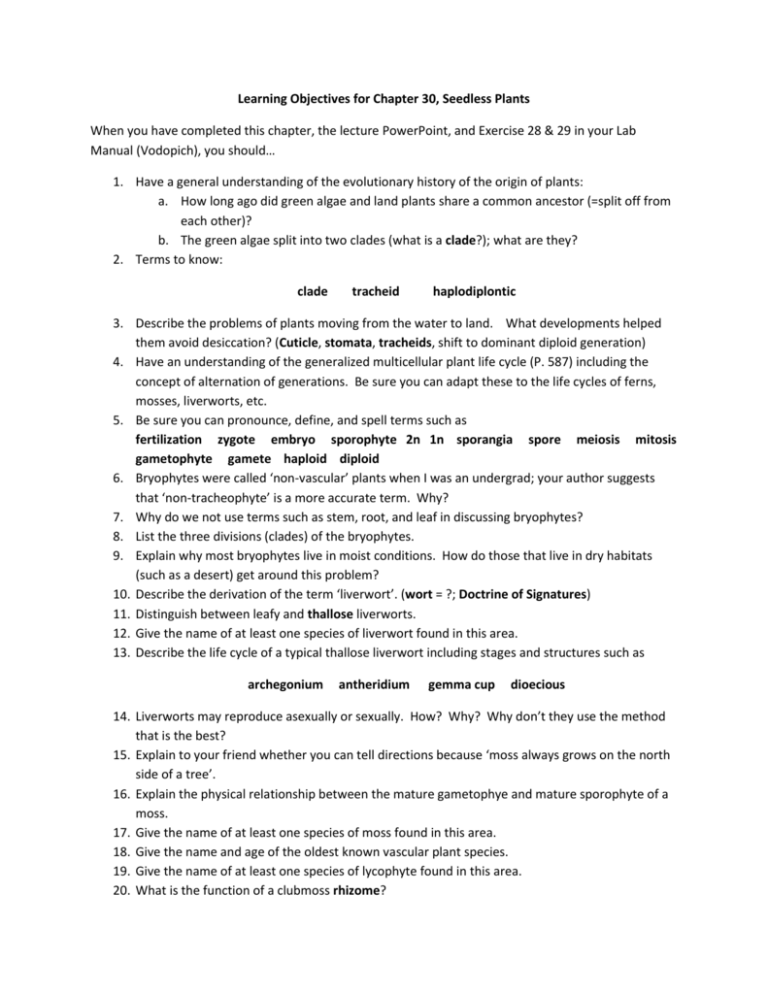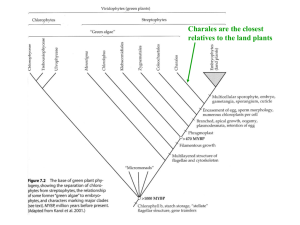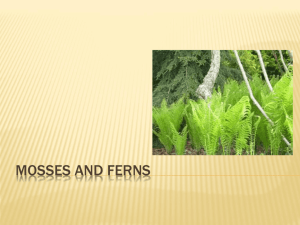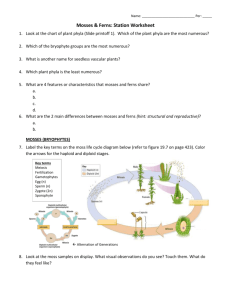Objectives
advertisement

Learning Objectives for Chapter 30, Seedless Plants When you have completed this chapter, the lecture PowerPoint, and Exercise 28 & 29 in your Lab Manual (Vodopich), you should… 1. Have a general understanding of the evolutionary history of the origin of plants: a. How long ago did green algae and land plants share a common ancestor (=split off from each other)? b. The green algae split into two clades (what is a clade?); what are they? 2. Terms to know: clade tracheid haplodiplontic 3. Describe the problems of plants moving from the water to land. What developments helped them avoid desiccation? (Cuticle, stomata, tracheids, shift to dominant diploid generation) 4. Have an understanding of the generalized multicellular plant life cycle (P. 587) including the concept of alternation of generations. Be sure you can adapt these to the life cycles of ferns, mosses, liverworts, etc. 5. Be sure you can pronounce, define, and spell terms such as fertilization zygote embryo sporophyte 2n 1n sporangia spore meiosis mitosis gametophyte gamete haploid diploid 6. Bryophytes were called ‘non-vascular’ plants when I was an undergrad; your author suggests that ‘non-tracheophyte’ is a more accurate term. Why? 7. Why do we not use terms such as stem, root, and leaf in discussing bryophytes? 8. List the three divisions (clades) of the bryophytes. 9. Explain why most bryophytes live in moist conditions. How do those that live in dry habitats (such as a desert) get around this problem? 10. Describe the derivation of the term ‘liverwort’. (wort = ?; Doctrine of Signatures) 11. Distinguish between leafy and thallose liverworts. 12. Give the name of at least one species of liverwort found in this area. 13. Describe the life cycle of a typical thallose liverwort including stages and structures such as archegonium antheridium gemma cup dioecious 14. Liverworts may reproduce asexually or sexually. How? Why? Why don’t they use the method that is the best? 15. Explain to your friend whether you can tell directions because ‘moss always grows on the north side of a tree’. 16. Explain the physical relationship between the mature gametophye and mature sporophyte of a moss. 17. Give the name of at least one species of moss found in this area. 18. Give the name and age of the oldest known vascular plant species. 19. Give the name of at least one species of lycophyte found in this area. 20. What is the function of a clubmoss rhizome? 21. Name the only genus of horsetails. Why are they nicknamed ‘scouring rush’? 22. Recall that ferns were major coal-producing plants; coal in the now eastern US is about 300 my old. 23. Determine whether the sporophyte or gametophyte generation is dominant in ferns. 24. Give the name of at least one species of fern found in this area. 25. Name and identify the parts of a fern such as the local Lady Fern, Athyriumfelix-femina, including protonema prothallium sporangium indusium sorus/sori fiddlehead/crozier frond stipe rachis rhizome sterile frond pinnate pinnatifid once/twice/thrice-divided pinna pinnule











